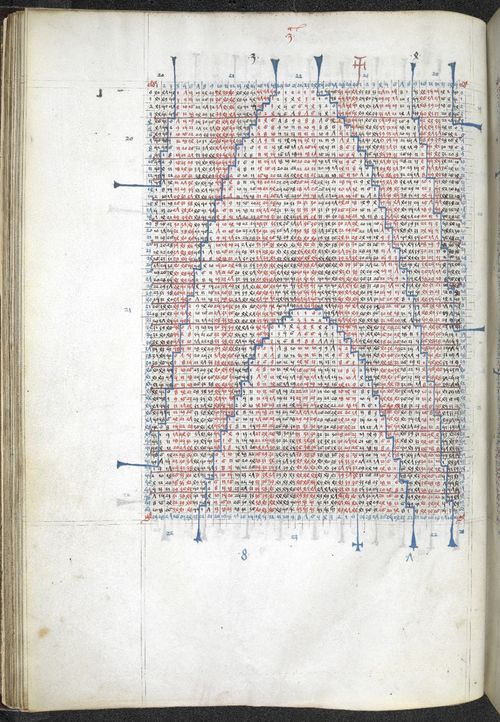
Astronomical table of John Killingworth, from a compilation of astrology and prophecy, England (London?), 1490, Arundel MS 66, f. 29v
Arundel MS 66 is a massive manuscript containing a highly
sophisticated collection of astronomical and astrological works. It combines texts on judicial astrology and
geomancy with astronomical tables, which were necessary tools to calculate the movements
of the planets and stars. As a comprehensive guide to techniques of forecasting
the future, it also contains an interesting selection of English political
prophecies.
Although its early provenance is
untraceable, it has long been suggested that Henry VII was the original patron or recipient of the codex, based largely
on the royal portrait and arms
included in a miniature on f. 201r (see below), as well as several heraldic badges incorporated
in borders, initials and miniatures throughout the text.
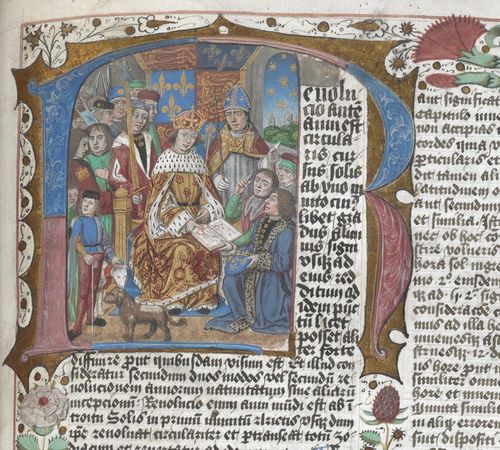
Detail of a miniature of Henry VII, surrounded by his courtiers, overseeing an
astrologer making a prediction for the forthcoming year, at the beginning of a treatise on the Revolution of the year of the world, from a compilation of astrology and prophecy, England (London?), 1490, Arundel MS 66, f. 201r
Amongst the elements that can be tied to
Henry VII and his family is the friendly Red Dragon of Cadwaladr, painted against the
Tudor livery colours of white and green; you may remember this miniature from the
opening displayed during the Royal Exhibition. This stand-out Red Dragon was
used in Arundel MS 66 in the place of the more usual image of the constellation Draco, in a section containing Ptolemy's
'Catalogue of Stars'.
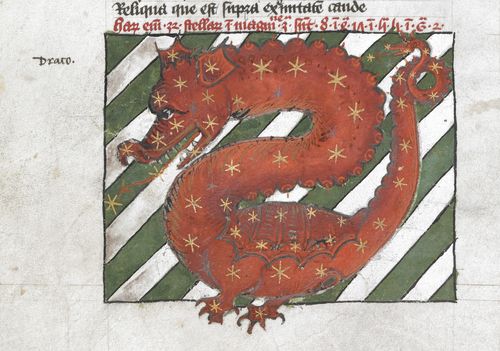
Detail of the constellation Draco, at the beginning of Ptolemy's Catalogue of Stars, from a compilation of astrology and prophecy, England (London?), 1490, Arundel MS 66, f. 33r
The main
text in this manuscript is the Decem tractatus astronomiae (or Liber
Astronomiae), a popular handbook
of astrology composed by the famous Italian
astrologer Guido Bonatti of Forli
(1207-1296). An otherwise blank leaf at the end of this text bears a note by the
scribe, John Wellys, which may give some insight into the production of the
book.
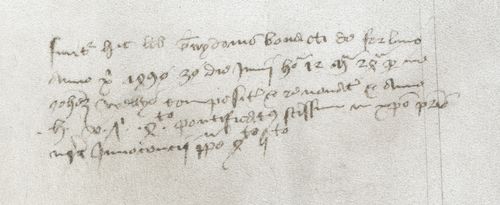
Detail of John Wellys' note at the end of Guido Bonatti's Decem tractatus astronomiae, from a compilation of astrology and prophecy, England (London?), 1490, Arundel MS 66, f. 249r
The note
reads:
'Finitur hic liber Guydonis
Bonacti de Forlivio anno Christi 1490 30 die junij hora 12 minuta 24a per me
Johannem Wellys compositus et renovatus et anno H. r. 7. 4to pontificatus
sanctissimi in Christo patris nostri Innocenti pape 4to [sic for 8to] 5to'.
Which translates to:
This
book by Guido Bonacti of Forlì was finished
in the year of Christ 1490, on the 30th day of June, 12 hours and 24
minutes, compiled and brought up-to-date by me
John Wellys in the 4th year of K[ing] H[enry] vii and in the 5th
year of the holy pontificate in Christ of our father pope Innocent IV [sic for
VIII].
Whether John Wellys was a trained astrologer or not, he dated the terminus of his work with an extraordinary precision
which reminds one of the language often used in astrological charts. Another good
example can be found in Egerton MS 889, which describes the birth date of Henry
VI in a similarly detailed way: 'Nativitas Henrici sexti anno Christi
imperfecto 1421°, 5a die Decembris post meridiem, 3 horam 20m 56s, die Veneris,
hora Saturni (Nativity of Henry VI in the imperfect year of Christ 1421, 5th
day of December, in the afternoon, at 3 hours 20 minutes and 56 seconds, on the
day of Venus, in the hour of Saturn).
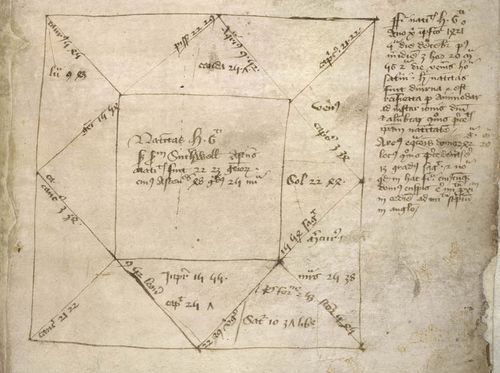
Diagram of the horoscope for the birth of Henry VI, from an astronomical and astrological compendium (the 'Codex Holbrookensis'), England (Cambridge), between c. 1420 and 1437, Egerton MS 889, f. 5r
In his note in Arundel MS 66, Wellys also scrupulously calculated
the regnal years of Henry VII and Innocent VIII. Both
the king and the pope came into power in August, in 1485 (22 August) and 1484
(29 August), respectively. Arundel MS 66 was completed in June of 1490,
therefore in the fourth year of Henry's reign and the fifth year of Innocent's pontificate.
John Wellys's inscription, jotted down on a blank leaf,
appears to be more an informal note than an polished colophon. What, then, was
its purpose, and what does this note tell us about the scribe's work? The way
Wellys used verbs is somewhat striking. He preferred to describe his activity
as 'componere' (to put together or
arrange) rather than the more commonly used 'scribere' (to write), implying that his task involved a work of
compilation. He also stressed the fact that he brought the text up to date ('renovatus'). Indeed, a closer look at
Wellys's rendering of Bonatti's Liber
astronomiae shows a great deal of editorial work. The scribe introduced his
own division of the text into not six but seven parts and therefore had to
alter Bonatti's preface. In the Tractatus
de Electionibus, one of the tracts forming the Liber astronimiae, his
ingenuity went even further. Wellys was clearly transcribing his text from an
imperfect model. The Tractatus in question contains several gaps and an
imperfect beginning.
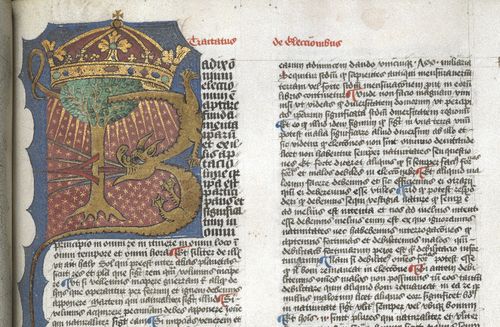
Detail of the imperfect beginning of Tractatus de Electionibus, with a miniature of Henry VII’s badge of a crowned tree, from a compilation of astrology and prophecy, England (London?), 1490, Arundel MS 66, f. 129r
Wellys did not bother with the two chapters missing at
the beginning of the tract, instead simply electing to open with chapter 3. However, a
large portion missing at the end seems to have caught his attention. By this
point in his labours he was working on royal commission, which may have had
something to do with his diligence! Not having another copy of
Bonatti's book at hand, Wellys decided to find the missing text elsewhere. On
ff. 143v-147v, he seamlessly replaced Bonatti's text on elections with an
extract from a similar work, De iudiciis astrorum (On the judgements of the
stars) by the Arabic author Haly ibn Ragel. Did King Henry ever notice the difference?
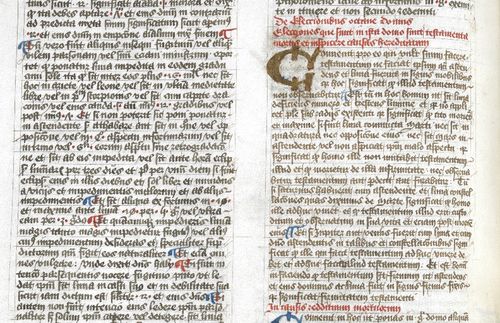
Detail of the incipit of Haly
ibn Ragel's De iudiciis astrorum
interpolated into Guido Bonatti's Tractatus de Electionibus, with the change of ink colour marking the beginning of the
interpolation, from a compilation of astrology and prophecy, England (London?), 1490, Arundel MS 66, f. 143v
To cover up his textual replacement, Wellys provided an inaccurate rubric at the end of the interpolated passage, which reads, 'expliciunt electiones
libri Guidonis' (here ends the elections of Guido's book).
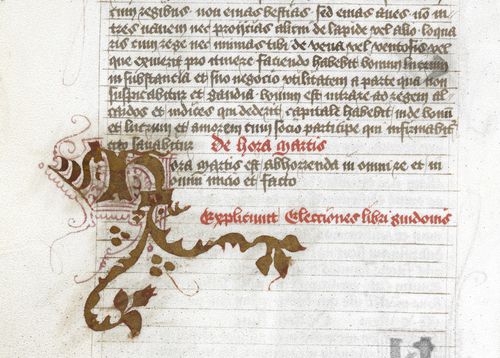
Detail of the explicit of Haly
ibn Ragel's De iudiciis astrorum
interpolated into Guido Bonatti's Tractatus de Electionibus, from a compilation of astrology and prophecy, England (London?), 1490, Arundel MS 66, f. 147v
Wellys copied part of the replacement text in an added
quire, in a different colour of ink from the rest of the manuscript. He used the same light brown ink to supply
the last two rubrics of the Tractatus de ymbribus
et aeris, the last tract of Bonatti's book (f. 248r), possibly during the same campaign of
revisions. If not for his unusually
worded colophon-note, I would have never discovered John Wellys's trick!
- Joanna Fronska
This post is based on my forthcoming
article 'The
Royal Image and Diplomacy: Henry VII’s Book of Astrology (British
Library, Arundel MS 66)' in the Electronic British Library Journal.
Follow us on Twitter: @blmedieval.